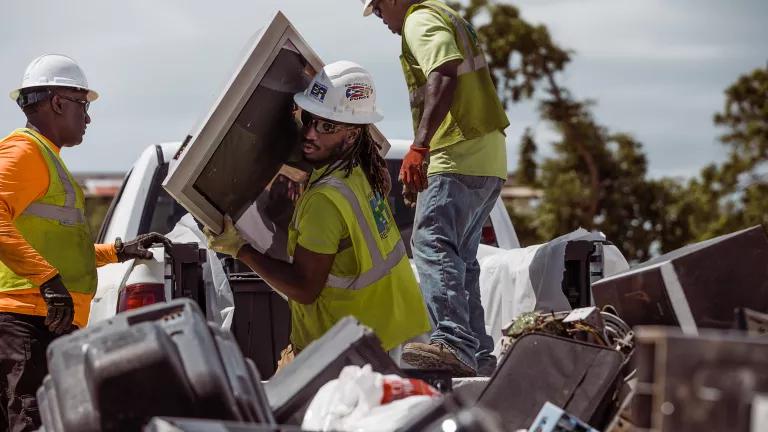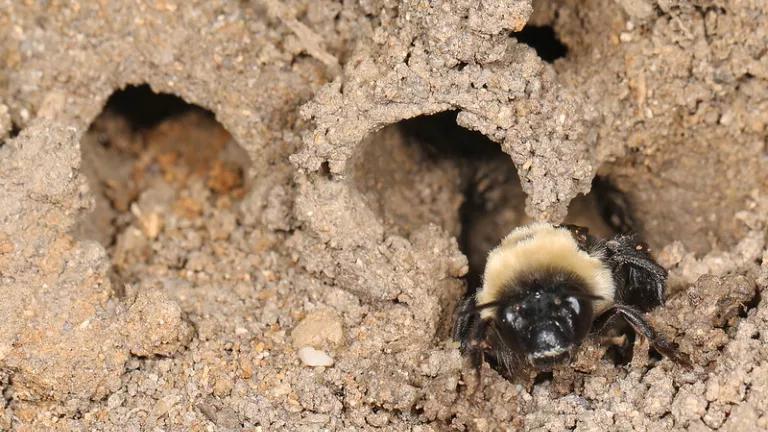Doing the Dirty Work: Resilience Workers Deserve Better

Following an extreme weather event, images of devastation and destruction endlessly occupy our TV screens and newsfeeds. Wildfires like the Camp Fire of 2018 left the entire town of Paradise, California destroyed. Flooding like the 2019 Midwestern floods left farms across the region totally inundated. In, 2019 Hurricanes Barry and Dorian and Tropical Storm Imelda pummeled the Carribean and the Gulf and East Coasts. All too often, however, the people who clean up and rebuild affected communities—and the challenges they face along the way—go largely unseen.
A comprehensive new report from Resilience Force and The New Florida Majority, A People’s Framework for Disaster Response: Rewriting the Rules of Recovery After Climate Disasters, outlines the ways in which local, state, and national policies fail to protect the “resilience workforce,” leaving workers vulnerable to dangerous conditions. The resilience workforce includes first responders and healthcare personnel, construction workers clearing debris and patching roofs, shelter workers and volunteers, and government staff and disaster planners. Many of these workers are people of color rebuilding their own communities, which are often hit first and worst by climate change and its impacts. Others are migrants, following disasters in hopes of securing temporary work and providing for their families.
According to the report, these already-vulnerable groups face multiple threats to their health and safety that make resilience work even more difficult and dangerous.
Living conditions
After a disaster, homes, hotels, and other buildings can be damaged or destroyed, leaving resident and incoming resilience workers without safe housing. Remaining living options can be far away from work sites or too expensive, leading many workers to live out of their cars. Homelessness can put stress on local communities and shelter systems, and contribute to negative health effects from insufficient food and poor sanitation. Employer-provided housing, when offered, is frequently inadequate and over-crowded, potentially putting workers in unsafe or unsanitary conditions. Workers may stay silent about poor housing or other workplace injustices for fear of losing what little housing they have.
Wage theft
Wage theft is prevalent during disaster cleanup because predatory employers know there is minimal oversight or enforcement of labor laws. Workers have reported unpaid overtime, withheld payments, bounced checks, and even the disappearance of contractors or site managers after a job is completed. A worker’s immigration status can also be used against them—reports of supervisors threatening to call the police or immigration services if employees seek fair payment are common.
Injury
Disaster response is dangerous business. Floodwaters, mold, downed power lines, hot weather, and long days can cause adverse health impacts like respiratory and digestive distress, heat illness, fatigue and exhaustion, and physical injury. Part-time or contract work doesn’t typically offer benefits, and health insurance is a luxury few can afford, meaning that getting injured on the job can drastically alter one’s ability to work in the future.
The report shares a story of Mario, who fell off of a roof he was working on after being asked to go up without a safety harness. He was knocked unconscious and broke his foot, but his supervisor refused to call an ambulance or report the injury. His supervisor disappeared after dropping him off at a hospital, which refused to perform the surgery without proof he could pay. They sent him to a homeless shelter, on a broken foot. Mario was eventually able to seek legal recourse and receive medical treatment. Calling him “lucky” would be an overstatement, but so many workers find themselves in similar situations and are unable to seek help.
Racism
People of color and migrant workers face intolerance, xenophobia, and racism, despite enduring harsh conditions to help restore communities. One account shared in the report referenced four men being fired from their job site because customers and employees “didn’t want to see Black people walking around.” Migrant workers commonly face harassment from law enforcement, as well as from members of the communities they are working to fix.
Steps can be taken to protect these workers
The report outlines a variety of recommendations to protect resilience workers from these hardships. When it comes to immediate disaster response, it is critical for systems like unemployment assistance, protections from rent gauging and eviction, and relocation support to be in place ahead of time. As disasters become more frequent, having a strong and deep-rooted social safety net of accessible healthcare, effective job training programs, and workplace protections for everyone are also necessary to ensure that recovery efforts can proceed without dangerous consequences for workers.
Some action is being taken already. The Asuncion Valdivia Heat Illness and Fatality Prevention Act was introduced to the U.S. House of Representatives last summer, directing the Occupational Safety and Health Administration (OSHA) to issue a national heat safety standard for workers. Such a standard would help protect workers from heat-related illnesses and make it easier to hold employers accountable for unsafe practices
In addition to a heat safety standard, the report proposes the development of a “Resilience Corps,” a public workforce designed to prepare for and respond to climate disasters. Legislation introduced in the House in November 2019 to establish a Climate Resiliency Service Corps would get part of the way there by providing young adults with job training and other support services.
2020 will mark 15 years since Hurricane Katrina hit New Orleans; since then, the United States has experienced nearly 200 billion-dollar disasters. The resilience workforce is only going to grow in size and be called upon more frequently and urgently in the future as disasters become stronger and occur more often because of climate change. We owe it to these workers to have strong protections in place to keep them safe, healthy, and fairly compensated.



